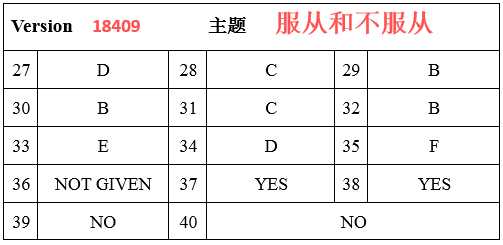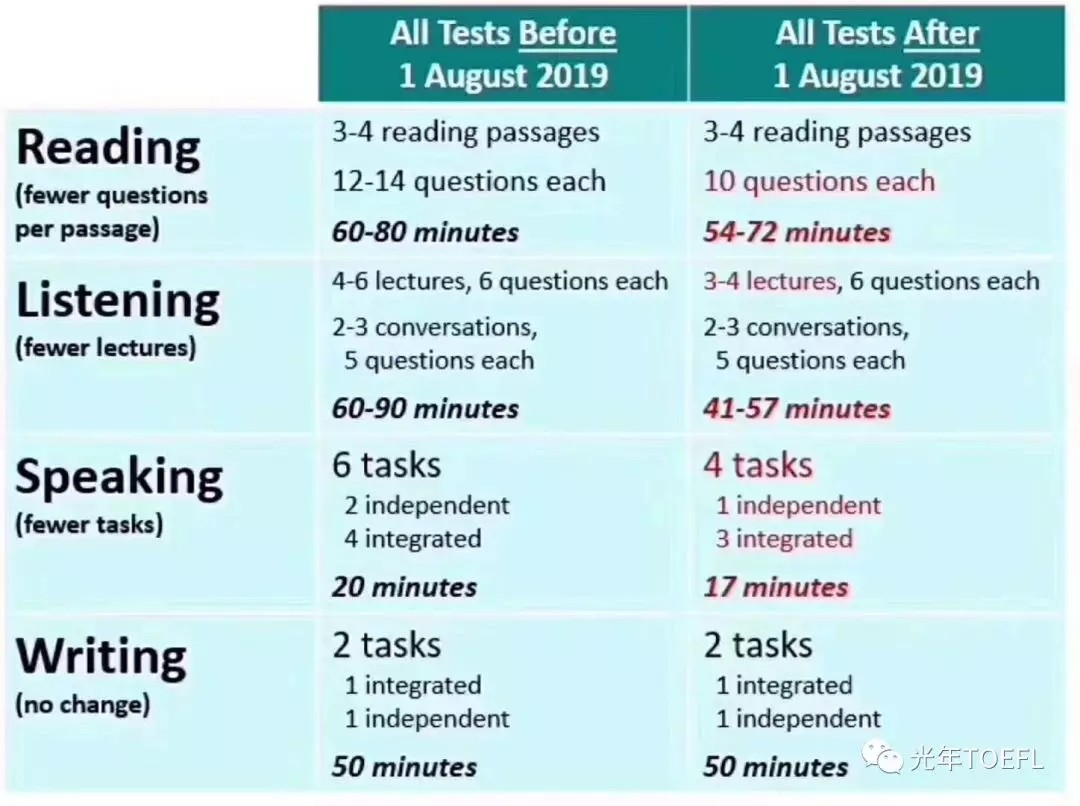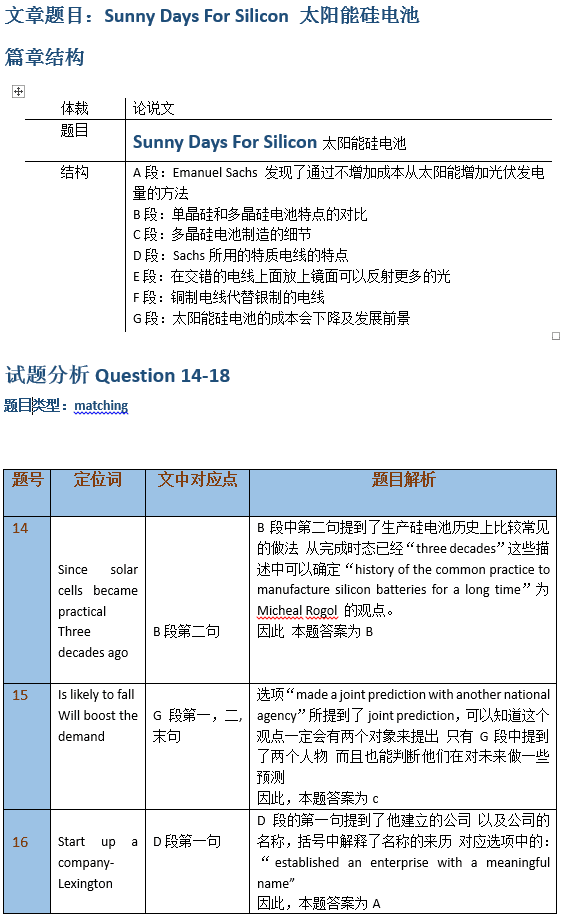有没有觉得阅读练习做很多,却没什么进步,下面小编给大家带来了雅思阅读14类题型解题技巧之直接填空,希望能够帮助到大家,下面小编就和大家分享,来欣赏一下吧。
雅思阅读14类题型解题技巧之直接填空
直接填空
与从选项中选词的摘要填空(SUMMARY)类似。题目是一小段文字,其中有几个空格,要求你从选项中选词填空。选项的数目常常比空格的数目要多。
与摘要填空不同的是,这种题形没有原文,所以我们称之为直接填空。
A类和G类都考过这种题型。G类通常是一段单独的小文章,A类是一篇长文章的一段(通常是最后一段)
这种题型一般不难。由于没有原文可以对应,所以语法在解题过程中起到很大的作用。具体解题步骤如下:
1. 根据空格前后的词,判断空格中应填词的词性。
2. 在选项中找出满足词性要求的词。
3. 结合句意,在选出的几个词中确定正确答案。
多选多+排序
与选择题中的多选多类似,只是在题目的要求中有IN THE CORRECT ORDER 的字样,即需要将选出的选项以正确的顺序排序,顺序非常重要。例如正确答案1、4、3、5、2,如果你的答案是1、3、4、5、2,则五道题中你答对了三道题,如果你的答案是3、4、5、2、1,则五道题你都答错了。在做这种题是,应注意以下几点:
1. 一般考做一件事情的过程,注意原文中的动词。
2. 正确答案的顺序一般与原文的叙述顺序是一致的。
3. 答案在原文中往往是集中出现的。
这种题型在实际考试中不常出现。
完成句子+搭配题
这种题型在实际考试中出现的频率高一些,它是完成句子和搭配题两种题型的结合。每个题目都是一个陈述句,但留有一个空格,而且都在句子的结尾。
与单纯的完成句子题型不同,这种题型不是要求你写出答案,而是从选项中选择。也就是说,在题目中还给出一个句子结尾的选项的集合。选项的数目要多于题目的数目。
做这种题型,应按照完成句子题型的方法去做,而不是按搭配题的方法去做。主要原因是题目是有顺序性的,只是在最后确定答案时,需要将原文中的词或短语与选项相对照。正确选项常常是原文中的词或短语的改写。
这种题型一般比较单纯的完成句子题型要简单一些。
全文主旨题
题目要求你说出一篇文章的主旨,即整篇文章的中心意思。这种题型也不常考,在实际考试中要么不考,要么只考一题。
做这种题型要注意下几点:
1. 题目以四选一的形式出现。
全文主旨题都是以四选一的形式出现,题干中常有THE AIM OF THE WRITER(作者写文章的目的)、THE TITLE(文章的标题)、THE MAIN THEME(文章的主旨)。
2. 最后做全文主旨题。
不管全文主旨题是文章的第一题还是最后一题,都在做完该篇文章的其它题目后,再做全文主旨题。这时,常常不需再看文章,即可直接做出来。如果不能确定,则需要看一下原文的第一段及每段话的第一句。一般全文主旨题还是比较简单的。
雅思阅读无限仿真模拟题详解:Compliance or Noncompliance for Children
Compliance or Noncompliance for Children
Many Scientists believe that socialization takes a long process, while compliance is the outset of it. Accordingly, compliance for education of children is the priority. Motivationally distinct forms of child compliance, mutually positive affect, and maternal control, observed in 3 control contexts in 103 dyads of mothers and their 26-41-month-old children, were examined as correlates of internalization, assessed using observations of children while alone with prohibited temptations and maternal ratings. One form of compliance (committed compliance), when the child appeared committed wholeheartedly to the maternal agenda and eager to endorse and accept it, was emphasized. Mother-child mutually positive affect was both a predictor and a concomitant of committed compliance. Children who shared positive affect with their mothers showed a high level of committed compliance and were also more internalized. Differences and similarities between children's compliance to requests and prohibitions ("Do" vs. "Don't" demand contexts) were also explored. Maternal "Dos" appeared more challenging to toddlers than the "Don't". Some individual coherence of behavior was also found across both demand contexts. The implications of committed compliance for emerging internalized regulators of conduct are discussed.
A number of parents were not easy to be aware of the compliance, some even overlooked their children's noncompliance. Despite good education, these children did not follow the words from their parents on several occasions, especially boys in certain ages. Fortunately, this rate was acceptable, some parents could be patient with the noncompliance. Someone held that noncompliance is probably not a wrong thing. In order to determine the effects of different parental disciplinary techniques on young children's compliance and noncompliance, mothers were trained to observe emotional incidents involving their own toddler-aged children. Reports of disciplinary encounters were analyzed in terms of the types of discipline used (reasoning, verbal prohibition, physical coercion, love withdrawal, and combinations thereof) and children's responses to that discipline (compliance/ noncompliance and avoidance). The relation between compliance/ noncompliance and type of misdeed (harm to persons, harm to property, and lapses of self-control) was also analyzed. Results indicated that love withdrawal combined with other techniques was most effective in securing children's compliance and that its effectiveness was not a function of the type of technique with which it was combined. Avoidant responses and affective reunification with the parent were more likely to follow love withdrawal than any other technique. Physical coercion was somewhat less effective than love withdrawal, while reasoning and verbal prohibition were not at all effective except when both were combined with physical coercion.
"Noncompliant Children sometimes prefer to say no directly as they were younger, they are easy to deal with the relationship with contemporaries when they are growing up. During the period that children is getting elder, who may learn to use more advanced approaches for their noncompliance. They are more skillful to negotiate or give reasons for refusal rather than show their opposite idea to parents directly," Said Henry Porter, scholar working in Psychology Institute of UK. He indicated that noncompliance means growth in some way, may have benefit for children. Many Experts held different viewpoints in recent years, they tried drilling compliance into children. His collaborator Wallace Freisen believed that Organizing child's daily activities so that they occur in the same order each day as much as possible. This first strategy for defiant children is ultimately the most important. Developing a routine helps a child to know what to expect and increases the chances that he or she will comply with things such as chores, homework, and hygiene requests. When undesirable activities occur in the same order at optimal times during the day, they become habits that are not questioned, but done without thought. Chances are that you have developed some type of routine for yourself in terms of showering, cleaning your house, or doing other types of work. You have an idea in your mind when you will do these things on a regular basis and this helps you to know what to expect. In fact, you have probably already been using most of these compliance strategies for yourself without realizing it. For children, without setting these expectations on a daily basis by making them part of a regular routine, they can become very upset. Just like adults, children think about what they plan to do that day and expect to be able to do what they want. So, when you come along and ask them to do something they weren't already planning to do that day, this can result in automatic refusals and other undesirable defiant behavior. However, by using this compliance strategy with defiant children, these activities are done almost every day in the same general order and the child expects to already do them.
Doctor Steven Walson addressed that organizing fun activities to occur after frequently refused activities. This strategy also works as a positive reinforcer when the child complies with your requests. By arranging your day so that things often refused occur right before highly preferred activities, you are able to eliminate defiant behavior and motivate your child's behavior of doing the undesirable activity. This is not to be presented in a way that the preferred activity is only allowed if a defiant child does the non-preferred activity. However, you can word your request in a way so that your child assumes that you have to do the non-preferred activity before moving on to the next preferred activity. For example, you do not want to say something such as, "If you clean your room we can play a game." Instead word your request like this, "As soon as you are done cleaning your room we will be able to play that really fun game you wanted to play."
Psychologist Paul Edith insisted praise is the best way to make children to comply with. This is probably a common term you are used to hearing by now. If you praise your child's behavior, he or she will be more likely to do that behavior. So, it is essential to use praise when working with defiant children. It also provides your child with positive attention. However, it is important to know how to praise children in a way that encourages future automatic reinforcement for your child when doing a similar behavior.
Question 27-31
Choose the correct letter, A, B, C, or D.
Write your answers in boxes 27-31 on your answer sheet.
27 The children, especially boys received good education may
A always comply with their parents' words
B be good at math
C have a high score at school
D disobey their parents’ order sometimes
28 Face to their children's compliance and noncompliance, parents
A must be aware of the compliance
B ask for help from their teachers
C some of them may ignore their noncompliance
D pretend not to see
29 According to Henry Porter, noncompliance for children
A are entirely harmful
B may have positive effects
C needs medicine assistance
D should be treated by expert doctor
30 When children are growing up, they
A always try to directly say no
B are more skillful to negotiate
C learn to cheat instead of noncompliance
D tend to keep silent
31 Which is the possible reaction the passage mentioned for elder children and younger ones if they don't want to comply with the order
A elder children prefer to refuse directly
B elder ones refuse to answer
C younger children may reject directly
D younger ones may save any words
Look at the following people and list of statements below.
Match each person with the correct statement.
Write the correct letter A-G in boxes 32-35 on your answer
32 Henry Porter
33 Wallace Freisen
34 Steven Walson
35 Paul Edith
List of statements
A children of all ages will indirectly show noncompliance
B elder children tend to negotiate rather than show noncompliance
C converse behavior means noncompliance
D organizing fun activities to occur after frequently refused activities
E organizing child's daily activities in the same order as much as possible
F use praise in order to make children compliant
G take the children to school at an early age
Question 36-40
Do the following statements agree with the information given in Reading Passage?
In boxes 36-40 on your answer sheet, write
YES if the statement is true
NO if the statement is false
NOT GIVEN if the information is not given in the passage
36 Socialization takes a long process, while compliance is the prior research subject.
37 Parents' cognition and attitude to their children's compliance or noncompliance are varied.
38 Younger children choose to be noncompliant because it may be simple to get along with the peers in the same age.
39 Experts never tried drilling compliance into children.
40 Psychologist Paul Edith negated the importance that knowing how to praise children in a encouraged way.
篇章结构
儿童的听从与不听从
体裁:论说文
结构:(一句话概括每段大意)
A段:对于孩子听从和不听从行为的探讨
B段:家长在孩子听从和不听从行为中扮演的角色
C段:英国心理学家对不听从行为表示理解以及反对者的观点
D段:反对者认为孩子应该听从的理由
E段:反对者给出如何让孩子听从的意见
F段:新的学者提出鼓励在听从与不听从行为中的作用。
试题分析:
Question 27-40
题目类型:
单选题 (5题) 答案: D C B B C
List of Statement人名配对 (4题) 答案:B E D F
T/F/NG (5题)答案:NG Y Y N N
参考译文:
许多科学家认为社会化是一个长期的过程,而听从正是其开端。相应地,对于孩子的听从观念的教育就成为优先考虑的问题,通过对3个控制组中103对母亲和她们26至于4个月的孩子的观察,激发性的儿童听从模式和来自母亲的控制有相互的正面影响,而这个结果作为孩子内在化的相关性研究,是通过给与实验组的孩子禁止性的诱惑和母亲对孩子干预的评级来评定的,听从的模式之一(忠诚性听从)是指孩子全身心地听从母亲的日程安排,并且很愿意去赞同和接受这种安排,母子之间这种正面的相互影响既是一种预示,也是忠城性听从随之而来的一种结果。能和母亲分享这种良好的正面影响的孩子表现出很高水平的忠诚性听从,同时也更加愿意把想法藏在心底。孩子对于要求的听从和禁止(“做”与“不做”的要求指示)的差异性和相似性也同时被探究出来。对于蹒跚学步的孩子来说,母亲对孩子的“做”的要求指示与“不做”的要求指示相比来说更有挑战性,而跨越这两种要求指示的一些个別的行为连贯性也被揭示。而忠诚性遵从作为日益显露的孩子行为的内在化的调节指标成为人们讨论的对象。
对于很多家长来说,让他们意识到听从这件事并不容易,一些家长甚至忽視孩子的不听从。即使对于一些接受了良好教育的孩子,他们在很多情况下也不听父母的话,尤其是到了一定年纪的男孩子。幸运的是,这种情况的比率还是在可接受范围内的,一些家长对于孩子的这种不听从还是表现出了耐心。有些人认为,孩子不听从大概也不是一件错的事情。为了确定不同的家长训诫方式对小孩子听从与不听从的影响,母亲往往需要训练有素,能够观察到她们蹒跚学步的孩子感情变化的细节。专家从使用的训诫方式的类型(包括讲道理,口头禁止,身体的压制,对孩子的关爱取消和以上几种方式的组合)以及孩子对这些训诫方式的反应(听从或是不听从还是回避)来分析这些有关训诫方式的报告。专家还分析了听 从与不听从和不端行为的类別(包括对別人的伤害,对财务的损坏以及自我控制的失误)之间的关系。结果显示,对孩子的关爱取消辅以其他的一些训诫方式在保证孩子听从父母意见方面是最有效的,结果还表明这种有效性并不是与关爱取消的训诫方式组合的其它方式的功能。和其它训诫方式相比,当父母对孩子取消关爱,孩子往往会对父母的命令产生回避性的反应,并表现出对父母的情感回归,和关爱取消的训诫方式相比,对孩子身体的压制没有那么有效,与此同时,讲道理和口头禁止也一点不起作用, 除非它们两个和身体压制这种方式相结合。
英国心理学研究所的学者Henry Porter曾说道:“不听话的孩子在他们还小的时候有时喜欢直接说“不”,在成长的过程中,他们容易处理和同龄人的关系问题。而当他们再长大些,他们学会用更高级的方式来表现他们的不听从。他们会更善于用和父母协商和向他们讲出拒绝的理由的方式,而不是直接向他们的父母表达反对的观点。”他指出, 孩子不听话某种程度上来讲意味着他们在成长,这对他们也许有利。近些年来,许多专家对此持不同的观点。他们试图训练孩子变得听话。Henry Porter的合作者Wallace Freisen认为,应该训练孩子的日常活动,让他们每天尽可能地有序地完成这些活动。 这是对反抗的孩子最最重要的优先策略。培养孩子的日常规范能够帮助他知道接下来要做什么,也能够加大他或她遵从对于像日常杂务,家庭作业还有卫生这些要求的机会。当一些他们讨厌的事情按着同样的顺序在一天中最理想的时间发生,它们就会成为一种不会被质疑的习惯,并且会不假思索的完成,极有可能你就会给自己养成一个固定的习惯,比如在洗澡,打扫房间或是做其它一些工作。当你养成习惯,在做这些事情的时候,你脑子里就知道该怎么做以及接下来会怎样。事实上,你很可能在没有意识的情况下采用了这种听从策略。对于孩子来说,不通过把这些变成一个他们每天生活的惯例,他们很容易就会很不安。就像大人一样,孩子打算好自己那天要做什么,也知道能得到自己期望的结果。因此,当你走过来让他们去做那天没有计划做的事情的时候,他们很容易就会自动拒绝或表现出其它反抗的行为。然而,对于一些反抗的孩子采用这种听从的策略,当这些事情在他们生活中几乎都会按同样的顺序出现的时候,每天几乎都会被完成而且孩子很期待去完成它们。
Seven Walson博士强调,在一些容易被孩子频繁拒绝的事情后面安棑一些有趣的事是很有必要的。这个方法在孩子很听从你的要求的情况下依然奏效。通过安排好时间,在孩子很想做的事情前面让他做他经常拒绝做的事情,会消除孩子的反抗行为并且会激发孩子愿意去做他本来讨厌的事情。这并不是说只有反抗的孩子做了不想做的事才可以做他想做的事。然而你可以通过口头表达出让你的孩子知道他必须先做自己不想做的事情,才能继续接下来做他想做的事情。比方说,不要说类似这样的话“如果你打扫了房间,你就可以玩会游戏”,而要把它变成这样说“你一打扫完房间就可以玩那个你特別想玩的很有意思的游戏了”。
心理学家Paul Edith坚持认为,表扬是让孩子听从的最佳方式。这可能是你目前为止听过的最熟悉不过的普通方式。如果你表扬了你孩子的某个行为,他/她很可能会重复那个行为。因此,在对付不听话的孩子的时候,表扬他们是很有必要的。表扬也会让你的孩子有一个正面的注意意识。但是把握好怎样表扬孩子好让他们做类似的事情的时候能够自发地去做是至关重要的。







